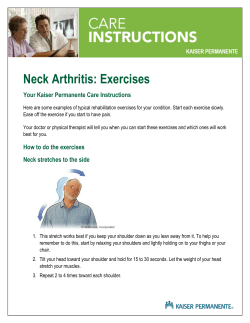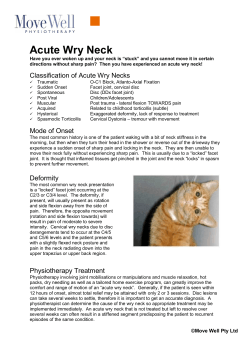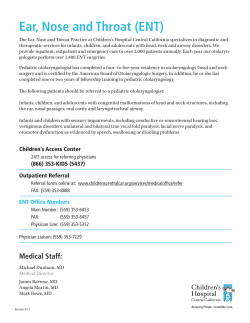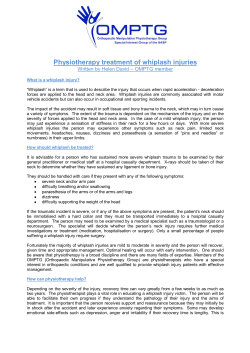
Cervical Exercise: How important is it? What can be done?
Cervical Exercise: The Backbone of Spine Treatment How important is it? What can be done? North American Spine Society Public Education Series Important: If you have had an accident that started your neck pain or if you have pain, numbness, tingling or weakness in your arm that is worsening, you should see your physician before starting any exercises. The Importance of Exercise for the Neck Spine experts agree that physical activity is important for people with neck pain. This brochure will show you how to stay active without making your pain worse. You can even reduce your pain by being active. Activity can also then protect you against your neck pain returning in the future. So how do you stay physically active without making your pain worse? Many people are surprised that carefully selected exercises can actually reduce pain. The exercises described in this brochure can often provide quick and significant relief, speed your recovery as well as keep your pain from returning. Once pain lessens or disappears, other exercises can help restore neck movement and muscle strength. These exercises will help you gain optimal recovery and help protect you against future episodes. If it is difficult to reduce your pain, many doctors believe returning to your activities is worthwhile. Even if pain increases, as long as that increase ceases as soon as the activity stops, that temporary additional pain is acceptable. So try to stay active. Selecting Exercises to Relieve Pain It is important to choose exercises carefully to avoid making your neck pain worse. One way to know if your neck problem is getting worse is if your symptoms spread away from the neck itself and into your shoulder or down your arm. This can happen during certain exercises or common activities such as driving, reading or using a computer for a prolonged period of time. The good news is that the opposite is also true! Symptoms can move out of your arm or shoulder so they are felt closer to the center or midline of your neck (called symptom “centralization”). When this happens, you are improving and moving toward recovery! You may be able to identify exercises and positions that can intentionally make that happen. When that is the case, once all symptoms have returned to the center of your neck, they will often decrease and disappear with continued exercise. Or if you only have pain in your neck, these same exercises will often eliminate that pain. Numbness or tin gling usually recovers as well, but sometimes more slowly than the pain. Four simple exercises often help centralize and reduce neck-related symptoms. When doing these exercises, as well as any other activities, monitor your pain and any numbness and tingling. Make sure they are moving toward the middle of your neck (centralizing), becoming less intense, or at least remaining the same. If they are moving further away from your neck, stop the exercise. Continue with those that help your pain the most; abandon those that aggravate your pain. Walking erectly with “neutral” head position (Figure 1): Make an effort to “walk tall” (chest up, shoulders back) and with your head positioned in “neutral.” This means your ears are aligned directly over your shoulders when viewed from the side. Allowing your head to fall into a forward position is a bad habit worth breaking because it so often contributes to neck pain and prolongs recovery. It initially requires an effort to consistently draw your head backward but, over time, this neutral position will become your new habit. Figure 1. Neutral head position Supine neutral head position (Figure 2): This exercise enables you to establish and maintain the “neutral” head position with very little effort, while resting. By lying on your back with as thin a pillow as is comfortable, or ideally with no pillow, let your head fall backward so your ears move toward being aligned with your shoulders and hips as much as you comfortably can. Spending 5-10 minutes in this position, perhaps every couple hours if necessary, often decreases or helps eliminate neck pain and allows your head to move further and further into that ideal alignment. Figure 2. Supine neutral head position Selecting Exercises... continued Supine retraction (Figure 3): While lying on your back with your head in neutral position, place your fingers on your chin and push downward so your chin tucks and your head is pushed downward into its resting surface. Be sure to feel a stretch in the back of your neck and a sense of “crowding” in the front of your neck. Repeat that stretch 8-10 times while monitoring your pain for either improvement or worsening. Stop the exercise if your pain is worsens as a result. Figure 3. Supine retraction Sitting or standing neck retraction (Figure 4): This exercise often reduces or eliminates pain by taking your head as far backward as possible, often well past the “neutral” position (Figure 1). Place your fingers on the front of your chin to help push your head backward as far as it will go, but maintain your face in a forward-direction. You will again feel a stretch in the back of your neck and a sense of “crowding” your throat in front. Hold that “retracted” stretching position for 1-2 seconds and then release, allowing your head to return to neutral. Repeat that movement 8-10 times and perform 3-4 such sessions each day, especially if you are finding it is reducing your pain. Often, as pain reduces, your head will retract further and further backward, making the exercise even more beneficial. Even after your pain is eliminated, continue this exercise 3-4 times daily for another two weeks to help prevent your pain from returning, or return to it any time your pain Figure 4. Sitting or does begin again. standing neck retraction Posture Is Very Important Too If your symptoms worsen while sitting, meaning they intensify or move away from your neck, toward or into your shoulder, or down your arm, it’s likely related to your posture. Most of us have a habit of slouching and letting our head protrude forward (Figure 5). A forward head position, especially when maintained for an extended period of time, commonly produces and aggravates painful neck conditions. To your painful lower neck, it is the equivalent of forward bending at the waist that so commonly aggravates a painful low back. Figure 5. Forward head position Good neck posture means placing and maintaining your head in a “neutral” position so, looking from the side, your ears are aligned directly over your shoulders (Figure 6). When you are unaccustomed to this position, it initially can feel awkward, like a chin-tucking position. But this new position places the weight of your head directly over your supporting spine, like a golf ball nicely sitting on a small golf tee. That minimizes the stresses on the discs and supporting ligaments in your neck. It is helpful to sit with the same hollow in our lower back that we have with standing and walking (Figure 6). The use of a lumbar roll or support for that hollow can make sitting erectly much easier, especially if the buttocks are positioned against the back of an upright chair. Avoiding deep soft chairs also assists in sitting erectly. Figure 6. Neutral head position while sitting It also helps at first to approach this new erect sitting posture as an exercise. That helps you practice finding this new head position as well as build the necessary stamina to hold this posture for longer and longer periods of time. Many also find pain relief by creating that same neutral head position by lying on their back using as thin a pillow as possible, or even no pillow at all. Establishing and maintaining the neutral head position is challenging at first, but can be a key to both recovery and preventing the return of your pain. You can determine the usefulness of these posture modifications by monitoring your own pain: specifically whether you are able to diminish, centralize or even eliminate it. If no exercise, movement or posture is found that will cause your pain to centralize, you may need further evaluation to determine your other treatment options. Exercising Once Pain Has Lessened In many cases, it may take only one or two days to control or eliminate symptoms. Once your pain is much better or gone, gradually and carefully return to any activities you’ve temporarily avoided and start some simple exercises. Continue as long as your symptoms do not return, get worse, or move away from the center of the back. Establishing that habit of sitting more erectly with your head in a neutral position, thus avoiding the protruded head position, is often necessary and valuable to establish long-term comfort. Strengthening Exercises Many people with neck pain also have weak muscles in the neck, upper back and core. By strengthening and stretching those muscles, more blood flow comes to the area to help repair injury. Your ability to function in your daily activities also improves. Stronger muscles provide greater stability to the neck and trunk to help establish and maintain good posture and enhance all body movements. Increasing strength helps protect you from future problems. Moderate strength training is one of the most valuable things you can do for your overall health and is especially important if you have neck pain. Continue exercises as long as your symptoms do not return, get worse, or move away from the center of the back. Special equipment and gyms can be helpful, but there are good, low-tech, inexpensive ways to strengthen neck muscles at home. Five simple exercises can help strengthen the muscles in your neck and upper back: Strengthening Can Help Isometric strengthening: 1. Sit in a chair with your back supported and your head in the neutral position (Figure 6). Place your hand across your forehead. Push your head and neck forward as hard as you are able while firmly resisting any movement of your head with your hand (Figure 7). Push for 10 seconds, then relax, and repeat three times. 2. Similarly, place your hand against the back of your head as you try to push your head backward (Figure 8) against the resistance of your hand. Push as hard as you are able for 10 seconds, relax, and repeat three times. 3. Do the same by bending your neck to either side, again pushing as hard as you can against the resistance of your hand that is placed against the side of your head (Figure 9). Push for 10 seconds, relax, and repeat three times. Figure 7. Forward isometric strengthening Figure 8. Backward isometric strengthening Figure 9. Sidward isometric strengthening Perform one set of each of these exercises twice a day. As you repeat them over time, you can vary the position of your head and neck as your hand resists your movement, bending slightly forward, backward, or to each side. These exercises will increase your neck strength in all directions of motion. Prone Head Lifts (Figure 10): Lying face down on a firm surface, raise your chest, shoulders and head up by resting on your elbows. Let your head hang fully downward so your chin is on or near your chest. Lift your head upward to the head-neutral position, being sure to retract your head (tuck your chin) as you move (Figure 6). Then continue lifting your head upward and backward as far as it will go in an attempt to look skyward. Hold that position for 5 seconds before slowly returning through that head-neutral position to the original downward head-hanging position. Repeat that exercise 5 times, twice a day. Figure 10. Prone head lift Supine Head Lifts (Figure 11): Lying on your back on a firm surface, raise your head fully off the surface, taking your chin to your chest, and hold for 5 seconds before returning to your starting position. Repeat that lift 8-10 times, twice a day. Figure 11. Supine head lift Scapular Retraction (Figure 12): Stand with your arms at your sides. Keep your head and neck in neutral position (Figure 1). With chest lifted, gently but firmly pull both shoulders backward while squeezing both shoulder blades backward and downward. Hold for 10 seconds and work up to 30 seconds. Perform one set of 5 repetitions, twice a day. You may add some resistance by stretching a towel or an elastic band across your chest while you pull your shoulders backward. Figure 12. Scapular retraction Neck Rotation (Figure 13): While sitting or standing with your head and neck in neutral position (Figure 6), slowly turn your head to the left as far as you comfortably can and hold for five seconds. Similarly, slowly turn the head to the right and hold for 5 seconds. Perform one set of 5 repetitions each direction, twice a day. Figure 13.Neck rotation Summary Exercising your neck is a very good thing to do, whether you are having pain or wishing to avoid it. Good neck care includes pain-relieving exercises that also help restore full neck movement, attention to head and neck posture, followed by moderate strengthening. These techniques can help you recover and provide a good defense against future symptoms. For More Information, Please Contact: North American Spine Society 7075 Veterans Boulevard Burr Ridge, IL 60527 Phone (866) 960-NASS (6277) Fax (630) 230-3700 Visit Us on the Internet at: www.KNOWYOURBACK.ORG DISCLAIMER This brochure is for general information and understanding only and is not intended to represent official policy of the North American Spine Society. Please consult your physician for specific information about your condition. © 2012 North American Spine Society Printed on recycled paper.
© Copyright 2025





















